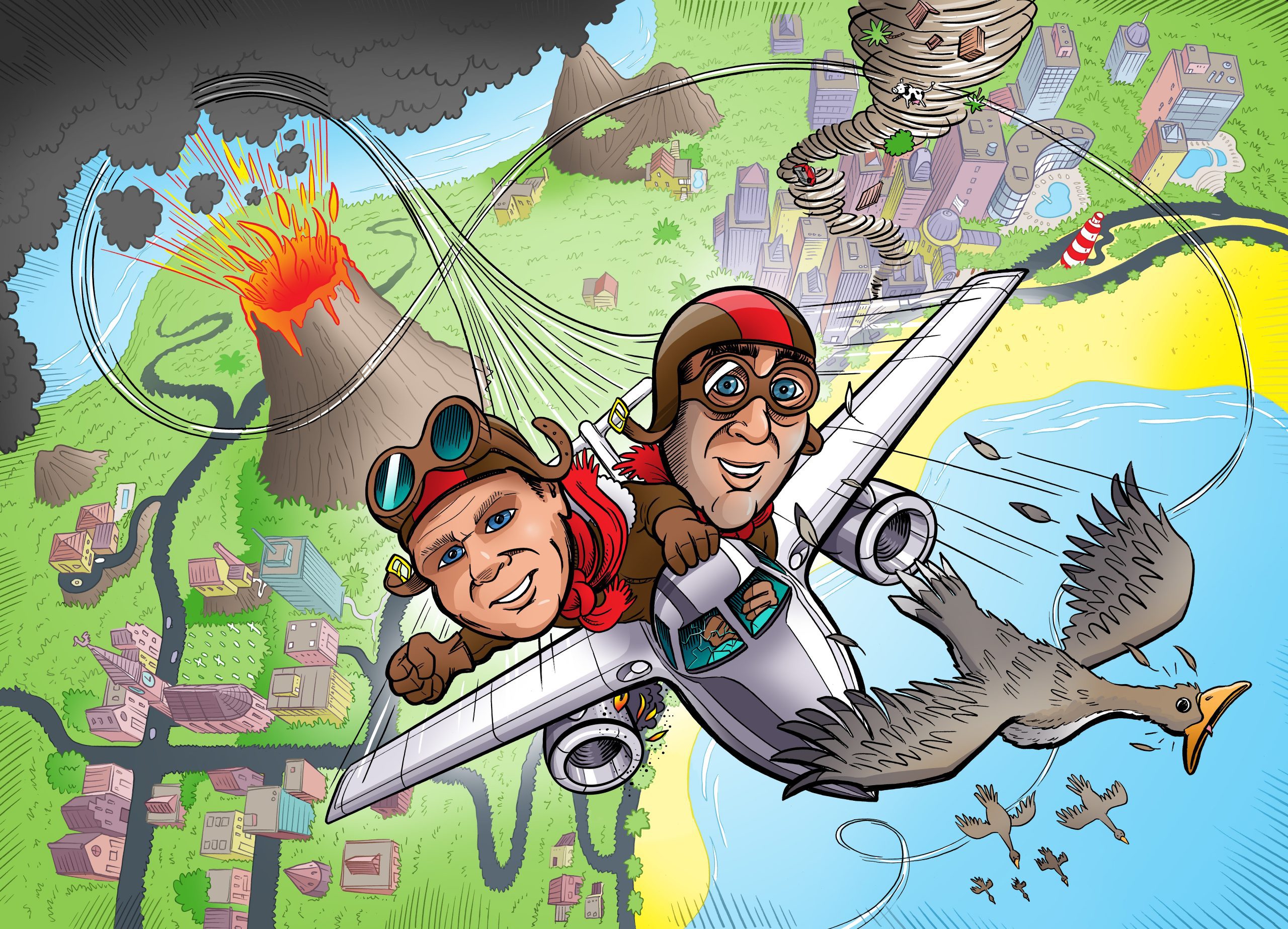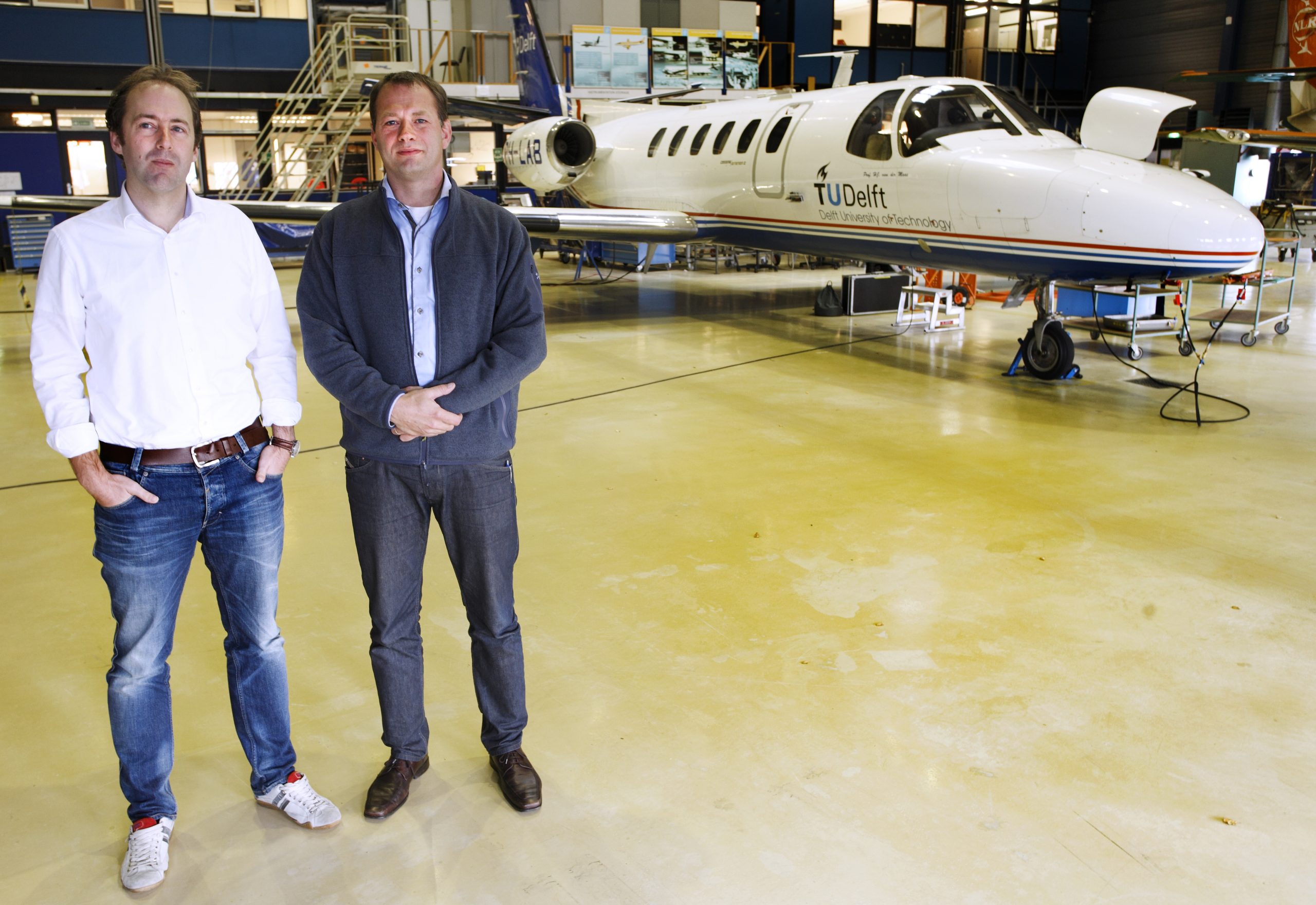Flying through clouds of ash, or flying on an damaged engine or a broken rudder; nothing fazes TU Delft pilots Hans Mulder and Alexander in ‘t Veld. These fearless pilots emulate aircraft incidents in the TU Delft Cessna Citation, thereby contributing to safer aviation.
Everything was going smoothly on an October morning in 2013 when TU pilots Hans Mulder and Dr Alexander in ’t Veld embarked on their landing manoeuvre. The contours of Woensdrecht military airbase loomed in the distance.
The aircraft made a gradual descent, and soon recognised the signals emitted by the airfield’s beacons. Normally, these radio signals (known as the Instrument Landing System or ILS) enable the autopilot to guide the aircraft along a safe glide path.
But things did not go entirely according to plan. As the plane dropped below a hundred metres, the autopilot failed and the aircraft started to climb steeply. The pilots could no longer rely on the primary flight display, the most important screen for pilots during a landing. This console shows whether the aircraft is on the right course. The middle line, which indicates the correct vertical course, had totally disappeared from the screen.
Mulder switched off the autopilot, let the aircraft dive and then accelerated, thereby creating lift. The pilots turned the plane around and made a smooth landing.
The two were not particularly shaken by the incident. But then, they had advance warning. In fact, they had been commissioned by the Dutch Safety Board to carry out this manoeuvre on purpose. It was a reconstruction of the landing of a Ryanair Boeing 737 (flight FR3531) on its journey from Palma de Mallorca to Eindhoven on 31 May 2013. The aircraft had been flying slightly too high when the autopilot made contact with the ILS, forcing it onto a false glide slope, a glide path that is too steep. The autopilot went completely haywire as soon as it locked onto this glide path. Mulder: “The pilots and passengers must have had a terrible fright.”
Warning
Mulder and In ’t Veld found the fault in the ILS. Thanks to the work carried out by these two pilots and the Dutch Safety Board, a worldwide warning was issued to aviation companies within just a few months.
In a hangar at Schiphol airport, Mulder shows me the Cessna Citation in which he, In ‘t Veld and four other colleagues carry out countless experiments to help improve safety in our airspace. The six of them form a pool of pilots, who fly for both TU Delft and the National Aerospace Laboratory (NLR). The NLR is co-owner of the aircraft.
Mulder, who also gives flying lessons in two- and four-person light aircraft, has been working as an engineer/pilot for seven years. In ‘t Veld has been on the team for ten years and is also a stunt pilot. Over the years, these two men have carried out numerous flights, some of which were just as spectacular as the aerobatic stunts that In ‘t Veld performs in his spare time. In 2011, for example, the pair intentionally flew into the airspace that had been closed to air traffic because of the ash clouds emitted by the Icelandic volcano Eyjafjallajökull (see item ‘Through the ash cloud’).
The year after that, they were the first to fly an aircraft on an alternative fuel consisting of 95% synthetic kerosene to test the safety of the mixture. They also carry out regular flights emulating weightlessness, known as parabolic flights. These flights involve plummeting to earth from great altitudes. Scientists sit behind them in the aircraft, carrying out experiments that require weightlessness, such as tests on set-ups to be used in space at a later date.
“Is our research dangerous? No,” says Mulder. “We make a complete safety analysis with the team before we embark on a special flight. We map the entire flight plan and think about everything that could go wrong.”
“You can’t compare this plane with other aircraft,” continues Mulder, pointing to the colossus. “It is packed with built-in sensors; on the aileron, the trim tabs… We are aware of the configuration of the whole aircraft during the entire flight. When we take a bend, we know exactly how many degrees per second we are banking. Most pilots don’t know things like this. They just make sure that the passengers feel comfortable when they turn the plane.”
Flight model
Next year, the pilots are in for an exciting time. The aircraft has been fitted with fly by wire, which means that you can take a computer on board and allow it take over the controls. Tests that until recently were only possible in flight simulators can now be carried out in the air.
The Bijlmer disaster of 1992 is a good example. The El Al aircraft that crashed had just lost two engines. Researchers who emulated the flight in the Simona flight simulator belonging to Aerospace Engineering managed to land the plane safely. They will soon attempt the same manoeuvre in the Cessna. “The engines obviously won’t actually fall off,” says In ’t Veld. “But the software that controls the aircraft will think that they have. An employee sitting behind us will programme it that way.”
“One of the things we want to investigate is whether we can make the control system respond to a new situation so that it can land the aircraft safely, despite the technical defect,” adds Mulder. “Imagine if a rudder stops working; you can still steer the aircraft by giving one engine more power than the other. So the software will have to adapt to a new type of flight model.”
Another problem is that in situations like this, you do not know the limits of the new aircraft configuration. For example: what’s the maximum banking angle for a plane in this condition? Mulder: “Predicting flight behaviour – envelope prediction in jargon – is a serious business.”
Air France flight AF447, which crashed into the Atlantic Ocean off the coast of Brazil on 1 June 2009, is also on our list. The aircraft’s speedometer was defective. The pilots had no idea that they were flying too slowly and stalled. The plane plunged into the sea from an altitude of ten kilometres.
Another area of flight research concerns providing information to the pilots. In both cases described above, the pilots were unaware that something had gone wrong with the aircraft. Aircraft are fitted with countless sensors, and so defects do not go unnoticed. The problem seems to be that pilots are not always given all the information.
In ’t Veld: “That’s how it works at the moment. The plane takes over from the pilot. Until something major goes wrong. Then the aircraft says, okay, you can take over now. But many pilots simply don’t know how to respond in these situations. We must make sure that pilots are given a lot more information. About what’s gone wrong, but more importantly, about how to resolve the problem.”


Flying on synthetic kerosene
Airline companies are allowed to mix their fuel for fifty percent with synthetic kerosene made from natural gas. This produces fewer polluting, sulphurous hydrocarbons. They are not allowed to mix more than this amount because aircraft engines run more smoothly if the fuel contains a certain amount of dirt. At least this was the assumption. Tests carried out by researchers in Delft have shown that engines run perfectly well on 95 percent synthetic kerosene.
But is this mixture safe when flying at higher altitudes, where the pressure and temperature are low and the air is thin? This is what Mulder and In ‘t Veld wanted to find out. So one of the Cessna’s engines was fitted with special fuel pumps and filters.
Mulder: “This fuel is more volatile than ordinary kerosene. The main question is whether you can restart an engine if it fails at a high altitude. So we turned off one of the engines at twelve kilometres and tried to restart it.”
In ‘t Veld: “If one of your engines fails, you can normally continue flying on the other one. Fuel is transferred from one wing to the other so that the weight difference doesn’t cause the aircraft to tilt. But in this case, we were unable to redistribute the fuel because we were flying on two different types. We had to make sure that the fuel levels in the wings were different before we took off to compensate for potential problems. Even then, we only had a maximum of one hour´s flying time on one engine before the centre of gravity shifted too far. This experiment required a very detailed and well thought-out plan.”
Through the ash cloud
Mulder and In ’t Veld set out to brave Icelandic airspace immediately after the Eyjafjallajökull volcano erupted in 2012. They were the only ones. Flying through the clouds of ash was prohibited. “The Minister gave us special permission,” says Mulder. “And we had to have a chat with our insurance…”
The aim of the exercise was to monitor the effect of ash particles on the engines, and to validate models relating to the dispersal of the ash cloud. The KNMI fitted the plane with a special ‘sniffer pipe’ to count the particles.
Ash is razor sharp. It can sandblast the engines, causing serious damage. The ash heats up and melts in the engines. When it cools down, it forms a glass-like layer on the turbines.
The pilots from Delft carried out several flights, venturing deeper into the ash cloud each time. In between flights, a borescope (a special engine endoscope) was used to inspect the aircraft’s engines. All in all, it was not as serious as had been expected as the concentrations were not high enough to cause damage to the engines.
“I can still see the pink/brown glow of the ash looming in the distance,” says Mulder. “You edge deeper and deeper into the ash cloud. We were actually the only people mad enough to fly into the airspace. That certainly got me thinking.”



Comments are closed.